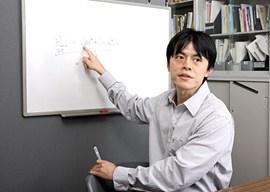2010/09/03
Made-in-Japan numerical computation formulas based on “structure-preserving methods”
Associate Professor Takayasu Matsuo
(Department of Mathematical Informatics)

Associate Professor Matsuo studies new numerical computation formulas using “structure-preserving methods” that recognize mathematical structure behind physical phenomena.
Key problems in natural science are often described by differential equations and their numerical computation is an essential tool in modern science. Since differential equations have been actively studied for long periods, general-purpose solutions have almost matured. Today, in order to tackle more advanced problems, specific solutions are sought for each problem. This approach was common for ordinary differential equations but is being applied to more complex partial differential equations in recent years. Ordinary differential equations focus on multiple points within fixed range, such as motion of robots and planets, while partial differential equations focus on an infinite number of points such as distributions of superconductive states. This shift from finite to infinite state makes it difficult to solve.
Partial differential equations are often used to describe natural phenomena associated with ”fields” such as fluid, gravitational fields, and magnetic fields and have wide application targeting at problems to be challenged by modern science including flight simulation, computer graphics, weather forecast, and mathematical economics. Associate Professor Matsuo pioneered the use of structure-preserving methods with partial differential equations from late 1990’s, which corresponds to the heyday of structure-preserving methods with ordinary differential equations, and applied the computational formulas developed through this approach to simulations of superconductive phenomena. Given that superconductive phenomena are based on the principle of nature in which “energy” decreases over time, he discovered a “physically correct” computational method in which “energy” always decreases correctly by identifying mathematical structure that exists in superconductive phenomena but was overlooked in the past. His dream is to challenge weather forecast and other research fields of big science in the future.